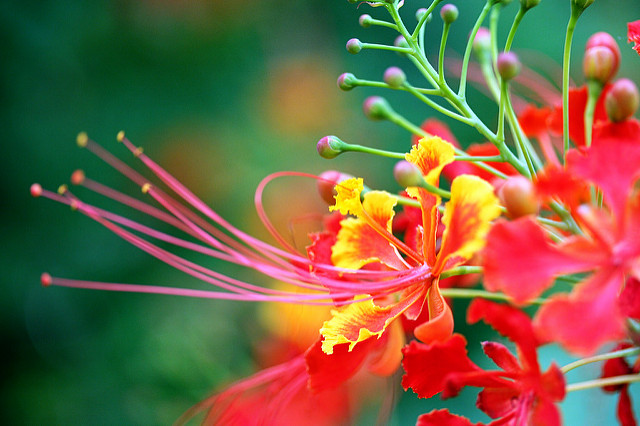Asia’s summit season blossoms
Posted By Graeme Dobell on November 20, 2017 @ 06:00

Asia’s summit season is bountiful. Flowers bloom, weeds sprout, thorns thrive, all coloured by policy and politics and the personalities of leaders.
The APEC summit and the East Asia Summit (EAS) bring lots of people together to do many things. The summits are multilateral events set amid a broader landscape of bilats and side meetings and myriad national and regional agendas.
The thriving flowers/weeds image responds to the question: What do summits achieve?
Answer: Meetings on the mount do service by commission and omission. What is agreed or attempted at the summit is fed by what’s avoided or fudged. The achievements list has several columns, including ‘successfully done’ and ‘successfully avoided’.
Substance mixes with symbolism—oft times it’s difficult to pick the reality beneath reams of rhetoric. The beauty of summit season is that it comes around annually. The continuum counts.
At the personality level, the season achieves something just by having Xi Jinping and Donald Trump spend quality time together in some different venues.
For Australia, summit season is a set element of the leader’s diary, an annual display of the shift of Australian international policy to the personal care of the prime minister [1]. Habit shouldn’t blind Australia to significance. Heading to APEC and the EAS, Malcolm Turnbull could reflect that previous leaders back to Gough Whitlam and Malcolm Fraser would exult at Australia’s place at Asia’s top tables.
We don’t often hear these days the dismissive line about Asia’s summits being empty talkfests enlivened by silly shirts. The need for talking has seldom been greater. The stakes build as old areas of agreement break down.
The rulers of the Indo-Pacific must run the rule across how the rules of the game are running. And at least nod in the direction of systemic questions about who will write the rules.
Summit season demands a certain comfort with imprecision: all those blossoms are colourful, not coherent. A neat division of roles would say APEC does economics and the EAS does security. This orderly classification just ain’t correct.
From the moment of its birth as the Cold War died, APEC has had a tacit security dimension beneath its economic plumage. The EAS is even more candid about its twin economic and security dimensions. The summits mirror each other—more continuum than contrast—which helps get around anomalies such as India’s absence from APEC.
Having reported lots of summits—do a dozen APEC summits amount to the waste of a life?—I subscribe to Henry Kissinger’s acid view that nothing is more dangerous than leaders thinking their personal chemistry and brilliance can quickly solve stuff. Leaders must be led up the mount carefully. Summits get to first base by doing no harm. And APEC and the EAS this year kept the mishaps under control.
At APEC, the Trans-Pacific Partnership avoided death: a smaller grouping [2] with a bigger name, now the Comprehensive and Progressive TPP [3]. For an old APECer, it’s still remarkable to see Japan leading in the creation of an Asia–Pacific trade structure that doesn’t include the US.
The failure of Canada’s prime minister to turn up at the TPP ratification looks more like stuff up than cunning diplomatic ploy. During the short summit season, time is tight and mishaps arrive quickly—stretched schedules can cause shock and schadenfreude. Even outside the reduced/redux TPP, US gravity matters: a Canada renegotiating its vital interests in NAFTA isn’t going to be diverted by marginal TPP gains.
In the Philippines, officials of the ‘quadrilateral’ [4]—the US, Japan, India and Australia—had a sidelines meeting ‘to discuss a shared vision for increased prosperity and security in the Indo-Pacific region and to work together to ensure it remains free and open’.
Three of the quad leaders—Donald Trump, Shinzo Abe and Malcolm Turnbull—had their own joint meeting.
The quad is up and running for its second incarnation. The first quad version was killed in 2008 by the new Labor government of Kevin Rudd, worried about the negative response of China. Labor’s signalling this time is that it’ll commit to Abe’s diamond of democracies.
The quad is about the Indo-Pacific. And this summit season the Indo-Pacific arrived with gusto. The Asia–Pacific may be enshrined in APEC’s title, but Indo-Pacific widens the arena and players. Hello, India!
The Trump adoption of the term Indo-Pacific is more than just the reflex instinct to junk anything inherited from Barack Obama. The Obama usage was Asia–Pacific, so of course Trump wants something bigger, better and different. Plus, the quad is another way to think about the China quandary.
China’s criticism of the quadrilateral reflects its distaste for the Indo-Pacific usage. Beijing sees Asia–Pacific as an expression of the core equation China–US, and it hates a new idiom that can be read as India–US.
Behold the beauty of summit season. Beyond the official flowers in the formal communiqué vases, there’s a riot of colour and movement.
Article printed from The Strategist: https://www.aspistrategist.org.au
URL to article: https://www.aspistrategist.org.au/asias-summit-season-blossoms/
URLs in this post:
[1] shift of Australian international policy to the personal care of the prime minister: https://www.aspistrategist.org.au/summit-season-cometh-pm-goeth/
[2] smaller grouping: https://thediplomat.com/2017/11/tpp-survives-after-canadians-screwed-everybody/
[3] Comprehensive and Progressive TPP: http://dfat.gov.au/trade/agreements/tpp/news/Pages/trans-pacific-partnership-ministerial-statement.aspx
[4] ‘quadrilateral’: http://dfat.gov.au/news/media/Pages/aus-india-japan-us-consultations-on-the-indo-pacific.aspx
Click here to print.